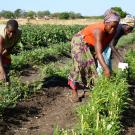Abstract from the article:
Background: The prevalence of undernutrition is decreasing in many parts of the developing world, but challenges remain in many countries. The objective of this study was to determine factors associated with temporal changes in childhood nutritional status in two countries in sub-Saharan Africa: Kenya and Zambia.
Methods: Data from national demographic and health surveys from the World Bank for Kenya (1998–2009) and Zambia (1996–2014) were used to select the youngest child of each household with complete data for all variables studied. Multiple linear regression analyses were used for data from 2902 and 11,335 children from Kenya and Zambia, respectively, in each year to determine the relationship between social and economic factors and measures of nutritional status, including wasting, stunting, and overweight.
Results: There was a decreased prevalence of stunting (35% in Kenya and 40% in Zambia), while the prevalence of wasting was unchanged (6–8% in both countries). From 1998 to 2009, there was a protective effect against stunting for wealthier families and households with electricity, for both countries. Finally, better educated mothers were less likely to have stunted children and girls were less likely to be stunted than boys.
Conclusions: Based on the data analyzed, there was a higher risk of stunting in both Kenya and Zambia, for those with lower literacy, less education, no electricity, living in rural areas, no formal toilet, no car ownership, and those with an overall lower wealth index. Improving the education of mothers was also a significant determinant in improving the nutritional status of children in Kenya and Zambia.
More broad-based efforts to reduce the prevalence of undernutrition need to focus on reducing the prevalence of undernutrition without promoting excess weight gain. Future economic advances need to consider integrated approaches to improving economic standings of households without increasing the risk for overnutrition.
Hoffman, D., T. Cacciola, P. Barrios and J. Simon. 2017. Temporal changes and determinants of childhood nutritional status in Kenya and Zambia. Journal of Health, Population and Nutrition. 36:27. doi:10.1186/s41043-017-0095-z

